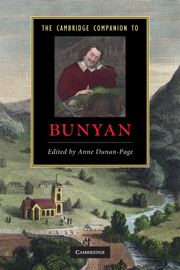Book contents
- Frontmatter
- Introduction
- Part I John Bunyan in his seventeenth-century context
- 1 John Bunyan’s literary life
- 2 John Bunyan and Restoration literature
- 3 John Bunyan and the Bible
- 4 John Bunyan and the goodwives of Bedford: a psychoanalytic approach
- Part II John Bunyan’s major works
- Part III Readership and reception
- Guide to further reading
- Index
1 - John Bunyan’s literary life
from Part I - John Bunyan in his seventeenth-century context
Published online by Cambridge University Press: 28 July 2010
- Frontmatter
- Introduction
- Part I John Bunyan in his seventeenth-century context
- 1 John Bunyan’s literary life
- 2 John Bunyan and Restoration literature
- 3 John Bunyan and the Bible
- 4 John Bunyan and the goodwives of Bedford: a psychoanalytic approach
- Part II John Bunyan’s major works
- Part III Readership and reception
- Guide to further reading
- Index
Summary
Bunyan might be thought the most improbable of authors. In a hierarchical age, when cultural patronage was in the hands of the court, the universities, the established church and London social elites, the literary prospects for a poorly educated provincial sectarian preacher might appear dim, and yet this same Bedfordshire tinker, 'of a low and inconsiderable generation' from one of the 'meanest, and most despised of all the families in the Land' (GA, p. 5), wrote nearly sixty works and, with The Pilgrim's Progress, became the century's bestselling writer. While, however, his success was exceptional, the fact of Bunyan's authorship was not quite as improbable as it might seem. His early literary career coincided with, and was shaped by, the unprecedented increase in press activity associated with the gathering momentum of the English Revolution. The political and religious tensions of the first half of the century were accompanied by, and articulated through, a proliferating press whose annual output rose from 625 titles in 1639 to 848 in 1640, over 2,000 in 1641 and over 3,666 in 1642, thereafter to continue at between one and two thousand annually until the Restoration. A unique record of this productivity is preserved in the remarkable collection of broadsides, tracts, pamphlets and books assembled by the bookseller George Thomason, who, between 1640 and 1661, amassed 22,000 publications. Never before had so many people turned to writing, never before had so many seen their thoughts into print and never before had what they printed generated such extensive interest and public debate.
- Type
- Chapter
- Information
- The Cambridge Companion to Bunyan , pp. 13 - 25Publisher: Cambridge University PressPrint publication year: 2010
- 2
- Cited by

